Phishers are enjoying remarkable success using text messages to steal remote access credentials and one-time passcodes from employees at some of the world’s largest technology companies and customer support firms. A recent spate of SMS phishing attacks from one cybercriminal group has spawned a flurry of breach disclosures from affected companies, which are all struggling to combat the same lingering security threat: The ability of scammers to interact directly with employees through their mobile devices.

In mid-June 2022, a flood of SMS phishing messages began targeting employees at commercial staffing firms that provide customer support and outsourcing to thousands of companies. The missives asked users to click a link and log in at a phishing page that mimicked their employer’s Okta authentication page. Those who submitted credentials were then prompted to provide the one-time password needed for multi-factor authentication.
The phishers behind this scheme used newly-registered domains that often included the name of the target company, and sent text messages urging employees to click on links to these domains to view information about a pending change in their work schedule.
The phishing sites leveraged a Telegram instant message bot to forward any submitted credentials in real-time, allowing the attackers to use the phished username, password and one-time code to log in as that employee at the real employer website. But because of the way the bot was configured, it was possible for security researchers to capture the information being sent by victims to the public Telegram server.
This data trove was first reported by security researchers at Singapore-based Group-IB, which dubbed the campaign “0ktapus” for the attackers targeting organizations using identity management tools from Okta.com.
“This case is of interest because despite using low-skill methods it was able to compromise a large number of well-known organizations,” Group-IB wrote. “Furthermore, once the attackers compromised an organization they were quickly able to pivot and launch subsequent supply chain attacks, indicating that the attack was planned carefully in advance.”
It’s not clear how many of these phishing text messages were sent out, but the Telegram bot data reviewed by KrebsOnSecurity shows they generated nearly 10,000 replies over approximately two months of sporadic SMS phishing attacks targeting more than a hundred companies.
A great many responses came from those who were apparently wise to the scheme, as evidenced by the hundreds of hostile replies that included profanity or insults aimed at the phishers: The very first reply recorded in the Telegram bot data came from one such employee, who responded with the username “havefuninjail.”
Still, thousands replied with what appear to be legitimate credentials — many of them including one-time codes needed for multi-factor authentication. On July 20, the attackers turned their sights on internet infrastructure giant Cloudflare.com, and the intercepted credentials show at least three employees fell for the scam.
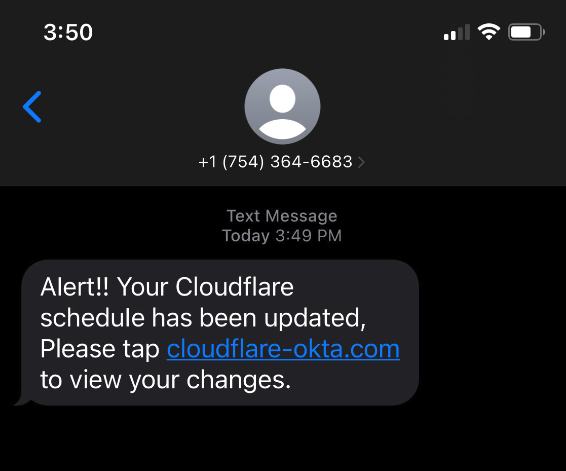
Image: Cloudflare.com
In a blog post earlier this month, Cloudflare said it detected the account takeovers and that no Cloudflare systems were compromised. Cloudflare said it does not rely on one-time passcodes as a second factor, so there was nothing to provide to the attackers. But Cloudflare said it wanted to call attention to the phishing attacks because they would probably work against most other companies.
“This was a sophisticated attack targeting employees and systems in such a way that we believe most organizations would be likely to be breached,” Cloudflare CEO Matthew Prince wrote. “On July 20, 2022, the Cloudflare Security team received reports of employees receiving legitimate-looking text messages pointing to what appeared to be a Cloudflare Okta login page. The messages began at 2022-07-20 22:50 UTC. Over the course of less than 1 minute, at least 76 employees received text messages on their personal and work phones. Some messages were also sent to the employees family members.”
On three separate occasions, the phishers targeted employees at Twilio.com, a San Francisco based company that provides services for making and receiving text messages and phone calls. It’s unclear how many Twilio employees received the SMS phishes, but the data suggest at least four Twilio employees responded to a spate of SMS phishing attempts on July 27, Aug. 2, and Aug. 7.
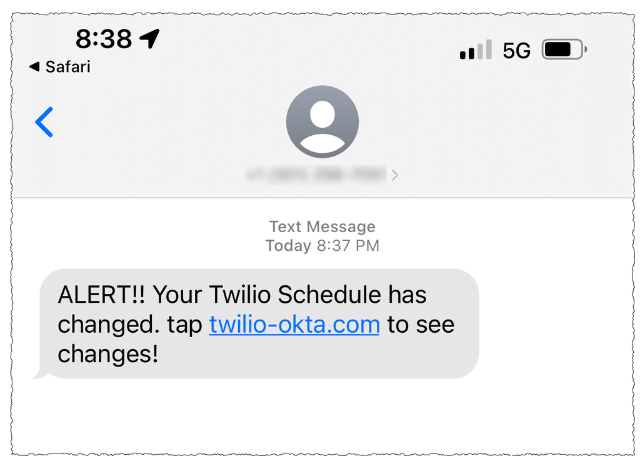
On that last date, Twilio disclosed that on Aug. 4 it became aware of unauthorized access to information related to a limited number of Twilio customer accounts through a sophisticated social engineering attack designed to steal employee credentials.
“This broad based attack against our employee base succeeded in fooling some employees into providing their credentials,” Twilio said. “The attackers then used the stolen credentials to gain access to some of our internal systems, where they were able to access certain customer data.”
That “certain customer data” included information on roughly 1,900 users of the secure messaging app Signal, which relied on Twilio to provide phone number verification services. In its disclosure on the incident, Signal said that with their access to Twilio’s internal tools the attackers were able to re-register those users’ phone numbers to another device.
On Aug. 25, food delivery service DoorDash disclosed that a “sophisticated phishing attack” on a third-party vendor allowed attackers to gain access to some of DoorDash’s internal company tools. DoorDash said intruders stole information on a “small percentage” of users that have since been notified. TechCrunch reported last week that the incident was linked to the same phishing campaign that targeted Twilio.
This phishing gang apparently had great success targeting employees of all the major mobile wireless providers, but most especially T-Mobile. Between July 10 and July 16, dozens of T-Mobile employees fell for the phishing messages and provided their remote access credentials.
“Credential theft continues to be an ongoing issue in our industry as wireless providers are constantly battling bad actors that are focused on finding new ways to pursue illegal activities like this,” T-Mobile said in a statement. “Our tools and teams worked as designed to quickly identify and respond to this large-scale smishing attack earlier this year that targeted many companies. We continue to work to prevent these types of attacks and will continue to evolve and improve our approach.”
This same group saw hundreds of responses from employees at some of the largest customer support and staffing firms, including Teleperformanceusa.com, Sitel.com and Sykes.com. Teleperformance did not respond to requests for comment. KrebsOnSecurity did hear from Christopher Knauer, global chief security officer at Sitel Group, the customer support giant that recently acquired Sykes. Knauer said the attacks leveraged newly-registered domains and asked employees to approve upcoming changes to their work schedules.
Knauer said the attackers set up the phishing domains just minutes in advance of spamming links to those domains in phony SMS alerts to targeted employees. He said such tactics largely sidestep automated alerts generated by companies that monitor brand names for signs of new phishing domains being registered.
“They were using the domains as soon as they became available,” Knauer said. “The alerting services don’t often let you know until 24 hours after a domain has been registered.”
On July 28 and again on Aug. 7, several employees at email delivery firm Mailchimp provided their remote access credentials to this phishing group. According to an Aug. 12 blog post, the attackers used their access to Mailchimp employee accounts to steal data from 214 customers involved in cryptocurrency and finance.
On Aug. 15, the hosting company DigitalOcean published a blog post saying it had severed ties with MailChimp after its Mailchimp account was compromised. DigitalOcean said the MailChimp incident resulted in a “very small number” of DigitalOcean customers experiencing attempted compromises of their accounts through password resets.
According to interviews with multiple companies hit by the group, the attackers are mostly interested in stealing access to cryptocurrency, and to companies that manage communications with people interested in cryptocurrency investing. In an Aug. 3 blog post from email and SMS marketing firm Klaviyo.com, the company’s CEO recounted how the phishers gained access to the company’s internal tools, and used that to download information on 38 crypto-related accounts.
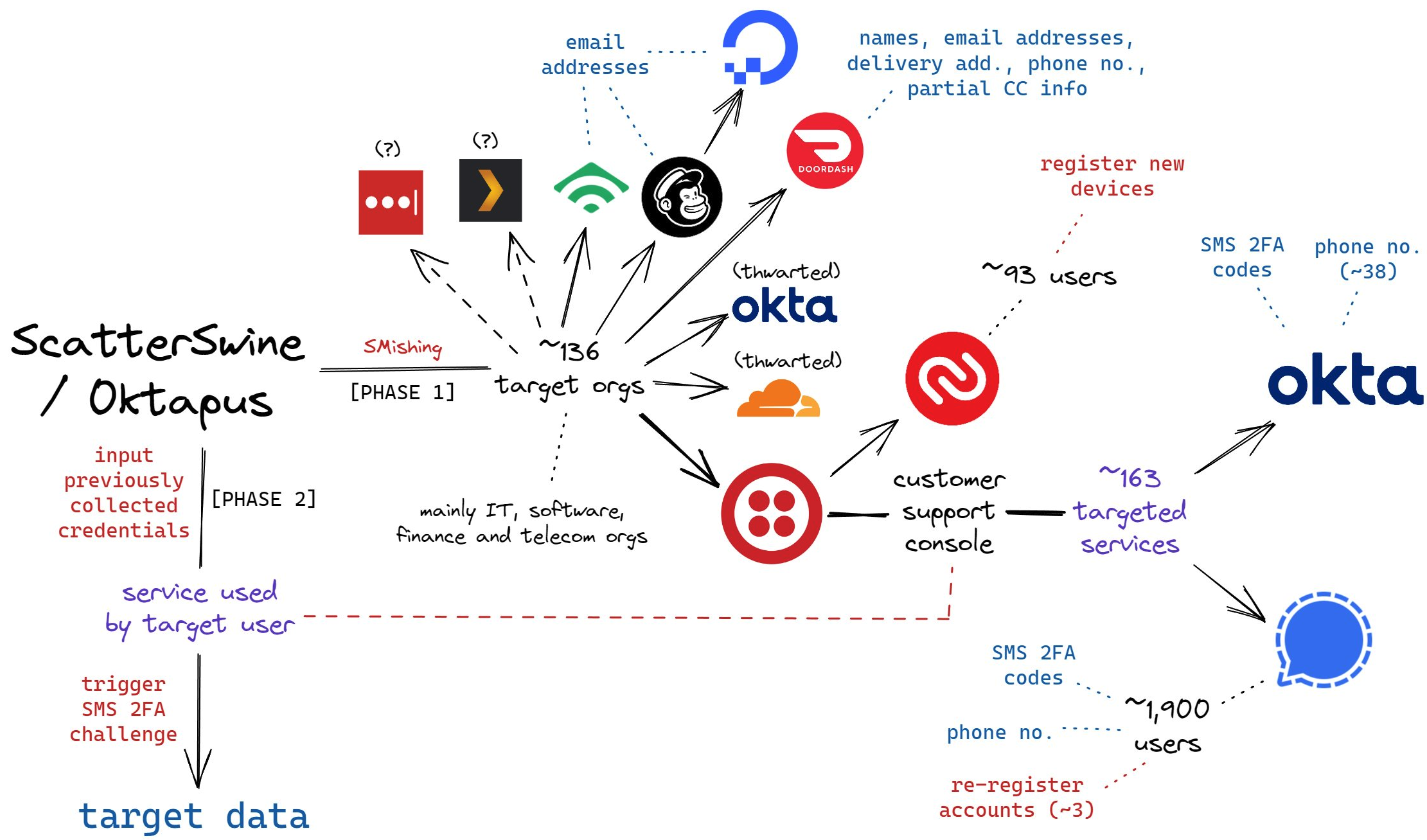
A flow chart of the attacks by the SMS phishing group known as 0ktapus and ScatterSwine. Image: Amitai Cohen for Wiz.io. twitter.com/amitaico.
The ubiquity of mobile phones became a lifeline for many companies trying to manage their remote employees throughout the Coronavirus pandemic. But these same mobile devices are fast becoming a liability for organizations that use them for phishable forms of multi-factor authentication, such as one-time codes generated by a mobile app or delivered via SMS.
Because as we can see from the success of this phishing group, this type of data extraction is now being massively automated, and employee authentication compromises can quickly lead to security and privacy risks for the employer’s partners or for anyone in their supply chain.
Unfortunately, a great many companies still rely on SMS for employee multi-factor authentication. According to a report this year from Okta, 47 percent of workforce customers deploy SMS and voice factors for multi-factor authentication. That’s down from 53 percent that did so in 2018, Okta found.
Some companies (like Knauer’s Sitel) have taken to requiring that all remote access to internal networks be managed through work-issued laptops and/or mobile devices, which are loaded with custom profiles that can’t be accessed through other devices.
Others are moving away from SMS and one-time code apps and toward requiring employees to use physical FIDO multi-factor authentication devices such as security keys, which can neutralize phishing attacks because any stolen credentials can’t be used unless the phishers also have physical access to the user’s security key or mobile device.
This came in handy for Twitter, which announced last year that it was moving all of its employees to using security keys, and/or biometric authentication via their mobile device. The phishers’ Telegram bot reported that on June 16, 2022, five employees at Twitter gave away their work credentials. In response to questions from KrebsOnSecurity, Twitter confirmed several employees were relieved of their employee usernames and passwords, but that its security key requirement prevented the phishers from abusing that information.
Twitter accelerated its plans to improve employee authentication following the July 2020 security incident, wherein several employees were phished and relieved of credentials for Twitter’s internal tools. In that intrusion, the attackers used Twitter’s tools to hijack accounts for some of the world’s most recognizable public figures, executives and celebrities — forcing those accounts to tweet out links to bitcoin scams.
“Security keys can differentiate legitimate sites from malicious ones and block phishing attempts that SMS 2FA or one-time password (OTP) verification codes would not,” Twitter said in an Oct. 2021 post about the change. “To deploy security keys internally at Twitter, we migrated from a variety of phishable 2FA methods to using security keys as our only supported 2FA method on internal systems.”
Update, 6:02 p.m. ET: Clarified that Cloudflare does not rely on TOTP (one-time multi-factor authentication codes) as a second factor for employee authentication.
Scammers are using invoices sent through PayPal.com to trick recipients into calling a number to dispute a pending charge. The missives — which come from Paypal.com and include a link at Paypal.com that displays an invoice for the supposed transaction — state that the user’s account is about to be charged hundreds of dollars. Recipients who call the supplied toll-free number to contest the transaction are soon asked to download software that lets the scammers assume remote control over their computer.
KrebsOnSecurity recently heard from a reader who received an email from paypal.com that he immediately suspected was phony. The message’s subject read, “Billing Department of PayPal updated your invoice.”
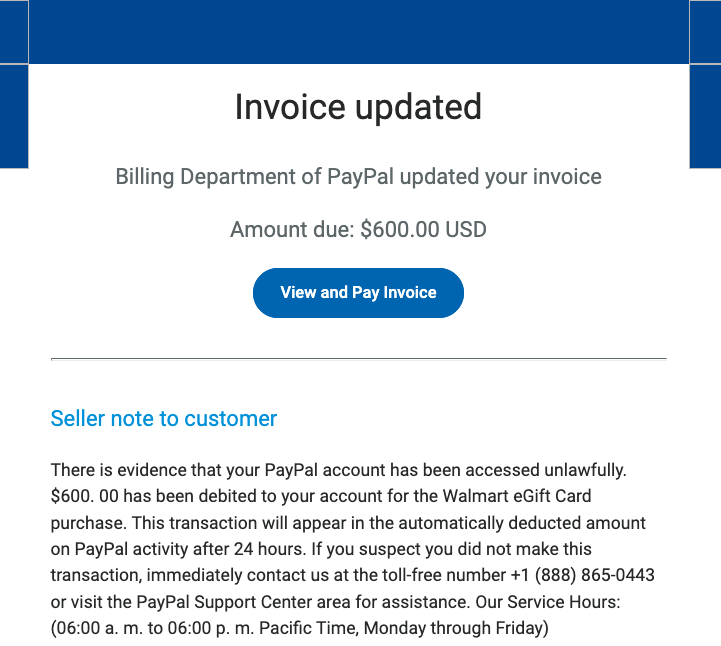
A copy of the phishing message included in the PayPal.com invoice.
While the phishing message attached to the invoice is somewhat awkwardly worded, there are many convincing aspects of this hybrid scam. For starters, all of the links in the email lead to paypal.com. Hovering over the “View and Pay Invoice” button shows the button indeed wants to load a link at paypal.com, and clicking that link indeed brings up an active invoice at paypal.com.
Also, the email headers in the phishing message (PDF) show that it passed all email validation checks as being sent by PayPal, and that it was sent through an Internet address assigned to PayPal.
Both the email and the invoice state that “there is evidence that your PayPal account has been accessed unlawfully.” The message continues:
“$600.00 has been debited to your account for the Walmart Gift Card purchase. This transaction will appear in the automatically deducted amount on PayPal activity after 24 hours. If you suspect you did not make this transaction, immediately contact us at the toll-free number….”
Here’s the invoice that popped up when the “View and Pay Invoice” button was clicked:
The reader who shared this phishing email said he logged into his PayPal account and could find no signs of the invoice in question. A call to the toll-free number listed in the invoice was received by a man who answered the phone as generic “customer service,” instead of trying to spoof PayPal or Walmart. Very quickly into the conversation he suggested visiting a site called globalquicksupport[.]com to download a remote administration tool. It was clear then where the rest of this call was going.
I can see this scam tricking a great many people, especially since both the email and invoice are sent through PayPal’s systems — which practically guarantees that the message will be successfully delivered. The invoices appear to have been sent from a compromised or fraudulent PayPal Business account, which allows users to send invoices like the one shown above. Details of this scam were shared Wednesday with PayPal’s anti-abuse (phishing@paypal.com) and media relations teams.
PayPal said in a written statement that phishing attempts are common and can take many forms.
“We have a zero-tolerance policy on our platform for attempted fraudulent activity, and our teams work tirelessly to protect our customers,” PayPal said. “We are aware of this well-known phishing scam and have put additional controls in place to mitigate this specific incident. Nonetheless, we encourage customers to always be vigilant online and to contact Customer Service directly if they suspect they are a target of a scam.”
It’s remarkable how well today’s fraudsters have adapted to hijacking the very same tools that financial institutions have long used to make their customers feel safe transacting online. It’s no accident that one of the most prolific scams going right now — the Zelle Fraud Scam — starts with a text message about an unauthorized payment that appears to come from your bank. After all, financial institutions have spent years encouraging customers to sign up for mobile alerts via SMS about suspicious transactions, and to expect the occasional inbound call about possibly fraudulent transactions.
Also, today’s scammers are less interested in stealing your PayPal login than they are in phishing your entire computer and online life with remote administration software, which seems to be the whole point of so many scams these days. Because why rob just one online account when you can plunder them all?
The best advice to sidestep phishing scams is to avoid clicking on links that arrive unbidden in emails, text messages and other mediums. Most phishing scams invoke a temporal element that warns of dire consequences should you fail to respond or act quickly. If you’re unsure whether the message is legitimate, take a deep breath and visit the site or service in question manually — ideally, using a browser bookmark to avoid potential typosquatting sites.

Image: Shutterstock.
A cybersecurity firm says it has intercepted a large, unique stolen data set containing the names, addresses, email addresses, phone numbers, Social Security Numbers and dates of birth on nearly 23 million Americans. The firm’s analysis of the data suggests it corresponds to current and former customers of AT&T. The telecommunications giant stopped short of saying the data wasn’t theirs, but it maintains the records do not appear to have come from its systems and may be tied to a previous data incident at another company.
Milwaukee-based cybersecurity consultancy Hold Security said it intercepted a 1.6 gigabyte compressed file on a popular dark web file-sharing site. The largest item in the archive is a 3.6 gigabyte file called “dbfull,” and it contains 28.5 million records, including 22.8 million unique email addresses and 23 million unique SSNs. There are no passwords in the database.
Hold Security founder Alex Holden said a number of patterns in the data suggest it relates to AT&T customers. For starters, email addresses ending in “att.net” accounted for 13.7 percent of all addresses in the database, with addresses from SBCGLobal.net and Bellsouth.net — both AT&T companies — making up another seven percent. In contrast, Gmail users made up more than 30 percent of the data set, with Yahoo addresses accounting for 24 percent. More than 10,000 entries in the database list “none@att.com” in the email field.
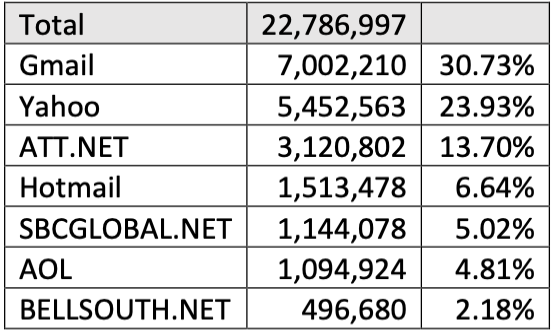
Hold Security found these email domains account for 87% of all domains in the data set. Nearly 21% belonged to AT&T customers.
Holden’s team also examined the number of email records that included an alias in the username portion of the email, and found 293 email addresses with plus addressing. Of those, 232 included an alias that indicated the customer had signed up at some AT&T property; 190 of the aliased email addresses were “+att@”; 42 were “+uverse@,” an oddly specific reference to an AT&T entity that included broadband Internet. In September 2016, AT&T rebranded U-verse as AT&T Internet.
According to its website, AT&T Internet is offered in 21 states, including Alabama, Arkansas, California, Florida, Georgia, Indiana, Kansas, Kentucky, Louisiana, Michigan, Missouri, Nevada, North Carolina, Ohio, Oklahoma, Tennessee, Texas and Wisconsin. Nearly all of the records in the database that contain a state designation corresponded to those 21 states; all other states made up just 1.64 percent of the records, Hold Security found.
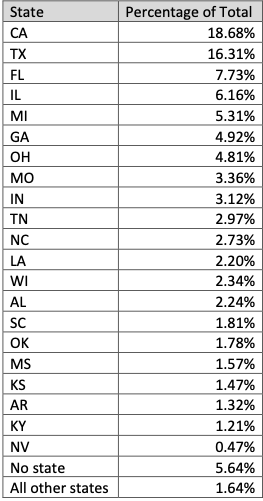
Image: Hold Security.
The vast majority of records in this database belong to consumers, but almost 13,000 of the entries are for corporate entities. Holden said 387 of those corporate names started with “ATT,” with various entries like “ATT PVT XLOW” appearing 81 times. And most of the addresses for these entities are AT&T corporate offices.
How old is this data? One clue may be in the dates of birth exposed in this database. There are very few records in this file with dates of birth after 2000.
“Based on these statistics, we see that the last significant number of subscribers born in March of 2000,” Holden told KrebsOnSecurity, noting that AT&T requires new account holders to be 18 years of age or older. “Therefore, it makes sense that the dataset was likely created close to March of 2018.”
There was also this anomaly: Holden said one of his analysts is an AT&T customer with a 13-letter last name, and that her AT&T bill has always had the same unique misspelling of her surname (they added yet another letter). He said the analyst’s name is identically misspelled in this database.
KrebsOnSecurity shared the large data set with AT&T, as well as Hold Security’s analysis of it. AT&T ultimately declined to say whether all of the people in the database are or were at some point AT&T customers. The company said the data appears to be several years old, and that “it’s not immediately possible to determine the percentage that may be customers.”
“This information does not appear to have come from our systems,” AT&T said in a written statement. “It may be tied to a previous data incident at another company. It is unfortunate that data can continue to surface over several years on the dark web. However, customers often receive notices after such incidents, and advice for ID theft is consistent and can be found online.”
The company declined to elaborate on what they meant by “a previous data incident at another company.”
But it seems likely that this database is related to one that went up for sale on a hacker forum on August 19, 2021. That auction ran with the title “AT&T Database +70M (SSN/DOB),” and was offered by ShinyHunters, a well-known threat actor with a long history of compromising websites and developer repositories to steal credentials or API keys.
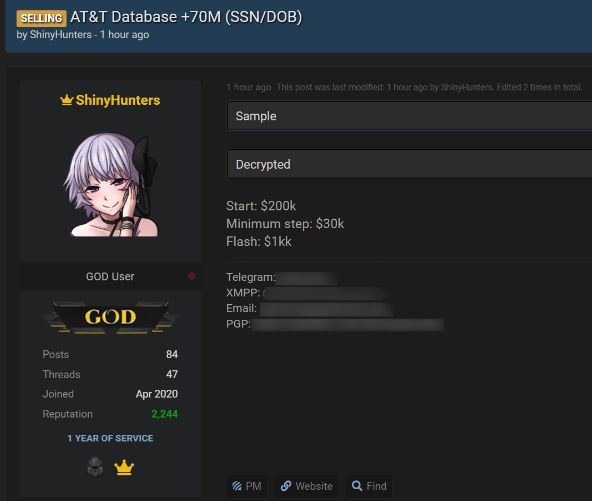
Image: BleepingComputer
ShinyHunters established the starting price for the auction at $200,000, but set the “flash” or “buy it now” price at $1 million. The auction also included a small sampling of the stolen information, but that sample is no longer available. The hacker forum where the ShinyHunters sales thread existed was seized by the FBI in April, and its alleged administrator arrested.
But cached copies of the auction, as recorded by cyber intelligence firm Intel 471, show ShinyHunters received bids of up to $230,000 for the entire database before they suspended the sale.
“This thread has been deleted several times,” ShinyHunters wrote in their auction discussion on Sept. 6, 2021. “Therefore, the auction is suspended. AT&T will be available on WHM as soon as they accept new vendors.”
The WHM initialism was a reference to the White House Market, a dark web marketplace that shut down in October 2021.
“In many cases, when a database is not sold, ShinyHunters will release it for free on hacker forums,” wrote BleepingComputer’s Lawrence Abrams, who broke the news of the auction last year and confronted AT&T about the hackers’ claims.
AT&T gave Abrams a similar statement, saying the data didn’t come from their systems.
“When asked whether the data may have come from a third-party partner, AT&T chose not to speculate,” Abrams wrote. “‘Given this information did not come from us, we can’t speculate on where it came from or whether it is valid,'” AT&T told BleepingComputer.
Asked to respond to AT&T’s denial, ShinyHunters told BleepingComputer at the time, “I don’t care if they don’t admit. I’m just selling.”
On June 1, 2022, a 21-year-old Frenchman was arrested in Morocco for allegedly being a member of ShinyHunters. Databreaches.net reports the defendant was arrested on an Interpol “Red Notice” at the request of a U.S. federal prosecutor from Washington state.
Databreaches.net suggests the warrant could be tied to a ShinyHunters theft in May 2020, when the group announced they had exfiltrated 500 GB of Microsoft’s source code from Microsoft’s private GitHub repositories.
“Researchers assess that Shiny Hunters gained access to roughly 1,200 private repositories around March 28, 2020, which have since been secured,” reads a May 2020 alert posted by the New Jersey Cybersecurity & Communications Integration Cell, a component within the New Jersey Office of Homeland Security and Preparedness.
“Though the breach was largely dismissed as insignificant, some images of the directory listing appear to contain source code for Azure, Office, and some Windows runtimes, and concerns have been raised regarding access to private API keys or passwords that may have been mistakenly included in some private repositories,” the alert continues. “Additionally, Shiny Hunters is flooding dark web marketplaces with breached databases.”
Last month, T-Mobile agreed to pay $350 million to settle a consolidated class action lawsuit over a breach in 2021 that affected 40 million current and former customers. The breach came to light on Aug. 16, 2021, when someone starting selling tens of millions of SSN/DOB records from T-Mobile on the same hacker forum where the ShinyHunters would post their auction for the claimed AT&T database just three days later.
T-Mobile has not disclosed many details about the “how” of last year’s breach, but it said the intruder(s) “leveraged their knowledge of technical systems, along with specialized tools and capabilities, to gain access to our testing environments and then used brute force attacks and other methods to make their way into other IT servers that included customer data.”
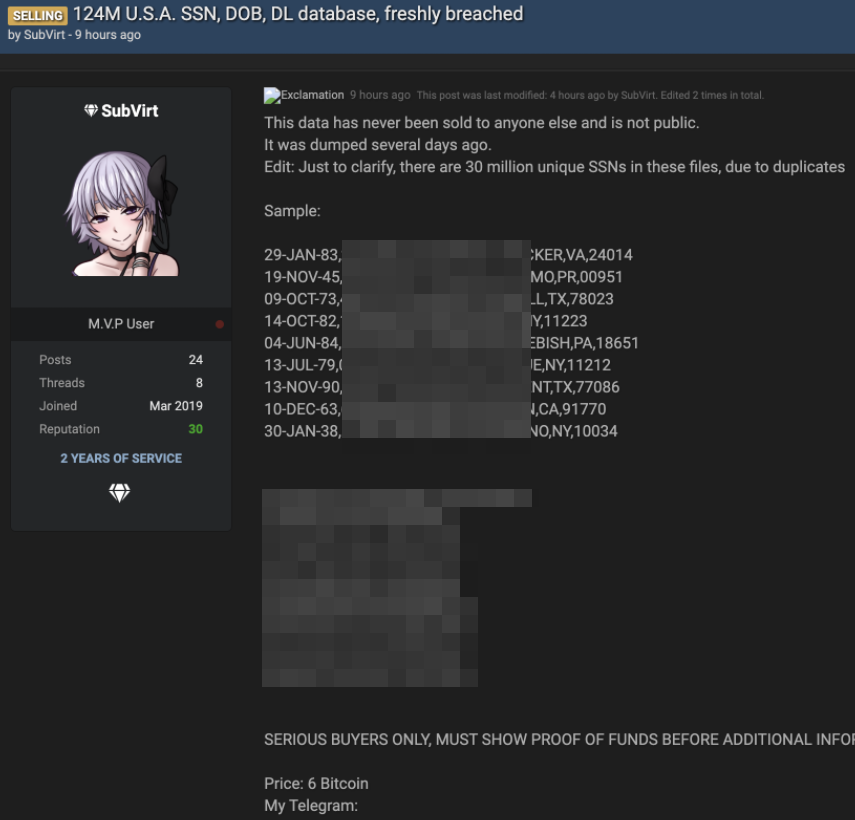
A sales thread tied to the stolen T-Mobile customer data.
Microsoft today released updates to fix a record 141 security vulnerabilities in its Windows operating systems and related software. Once again, Microsoft is patching a zero-day vulnerability in the Microsoft Support Diagnostics Tool (MSDT), a service built into Windows. Redmond also addressed multiple flaws in Exchange Server — including one that was disclosed publicly prior to today — and it is urging organizations that use Exchange for email to update as soon as possible and to enable additional protections.

In June, Microsoft patched a vulnerability in MSDT dubbed “Follina” that had been used in active attacks for at least three months prior. This latest MSDT bug — CVE-2022-34713 — is a remote code execution flaw that requires convincing a target to open a booby-trapped file, such as an Office document. Microsoft this month also issued a different patch for another MSDT flaw, tagged as CVE-2022-35743.
The publicly disclosed Exchange flaw is CVE-2022-30134, which is an information disclosure weakness. Microsoft also released fixes for three other Exchange flaws that rated a “critical” label, meaning they could be exploited remotely to compromise the system and with no help from users. Microsoft says addressing some of the Exchange vulnerabilities fixed this month requires administrators to enable Windows Extended protection on Exchange Servers. See Microsoft’s blog post on the Exchange Server updates for more details.
“If your organization runs local exchange servers, this trio of CVEs warrant an urgent patch,” said Kevin Breen, director of cyber threat research for Immerse Labs. “Exchanges can be treasure troves of information, making them valuable targets for attackers. With CVE-2022-24477, for example, an attacker can gain initial access to a user’s host and could take over the mailboxes for all exchange users, sending and reading emails and documents. For attackers focused on Business Email Compromise this kind of vulnerability can be extremely damaging.”
The other two critical Exchange bugs are tracked as CVE-2022-24516 and CVE-2022-21980. It’s difficult to believe it’s only been a little more than a year since malicious hackers worldwide pounced in a bevy of zero-day Exchange vulnerabilities to remotely compromise the email systems for hundreds of thousands of organizations running Exchange Server locally for email. That lingering catastrophe is reminder enough that critical Exchange bugs deserve immediate attention.
The SANS Internet Storm Center‘s rundown on Patch Tuesday warns that a critical remote code execution bug in the Windows Point-to-Point Protocol (CVE-2022-30133) could become “wormable” — a threat capable of spreading across a network without any user interaction.
“Another critical vulnerability worth mentioning is an elevation of privilege affecting Active Directory Domain Services (CVE-2022-34691),” SANS wrote. “According to the advisory, ‘An authenticated user could manipulate attributes on computer accounts they own or manage, and acquire a certificate from Active Directory Certificate Services that would allow elevation of privilege to System.’ A system is vulnerable only if Active Directory Certificate Services is running on the domain. The CVSS for this vulnerability is 8.8.”
Breen highlighted a set of four vulnerabilities in Visual Studio that earned Microsoft’s less-dire “important” rating but that nevertheless could be vitally important for the security of developer systems.
“Developers are empowered with access to API keys and deployment pipelines that, if compromised, could be significantly damaging to organizations,” he said. “So it’s no surprise they are often targeted by more advanced attackers. Patches for their tools should not be overlooked. We’re seeing a continued trend of supply-chain compromise too, making it vital that we ensure developers, and their tools, are kept up-to-date with the same rigor we apply to standard updates.”
Greg Wiseman, product manager at Rapid7, pointed to an interesting bug Microsoft patched in Windows Hello, the biometric authentication mechanism for Windows 10. Microsoft notes that the successful exploitation of the weakness requires physical access to the target device, but would allow an attacker to bypass a facial recognition check.
Wiseman said despite the record number of vulnerability fixes from Redmond this month, the numbers are slightly less dire.
“20 CVEs affect their Chromium-based Edge browser and 34 affect Azure Site Recovery (up from 32 CVEs affecting that product last month),” Wiseman wrote. “As usual, OS-level updates will address a lot of these, but note that some extra configuration is required to fully protect Exchange Server this month.”
As it often does on Patch Tuesday, Adobe has also released security updates for many of its products, including Acrobat and Reader, Adobe Commerce and Magento Open Source. More details here.
Please consider backing up your system or at least your important documents and data before applying system updates. And if you run into any problems with these updates, please drop a note about it here in the comments.

The 911 service as it existed until July 28, 2022.
911[.]re, a proxy service that since 2015 has sold access to hundreds of thousands of Microsoft Windows computers daily, announced this week that it is shutting down in the wake of a data breach that destroyed key components of its business operations. The abrupt closure comes ten days after KrebsOnSecurity published an in-depth look at 911 and its connections to shady pay-per-install affiliate programs that secretly bundled 911’s proxy software with other titles, including “free” utilities and pirated software.
911[.]re is was one of the original “residential proxy” networks, which allow someone to rent a residential IP address to use as a relay for his/her Internet communications, providing anonymity and the advantage of being perceived as a residential user surfing the web.
Residential proxy services are often marketed to people seeking the ability to evade country-specific blocking by the major movie and media streaming providers. But some of them — like 911 — build their networks in part by offering “free VPN” or “free proxy” services that are powered by software which turns the user’s PC into a traffic relay for other users. In this scenario, users indeed get to use a free VPN service, but they are often unaware that doing so will turn their computer into a proxy that lets others use their Internet address to transact online.
From a website’s perspective, the IP traffic of a residential proxy network user appears to originate from the rented residential IP address, not from the proxy service customer. These services can be used in a legitimate manner for several business purposes — such as price comparisons or sales intelligence — but they are massively abused for hiding cybercrime activity because they can make it difficult to trace malicious traffic to its original source.
As noted in KrebsOnSecurity’s July 19 story on 911, the proxy service operated multiple pay-per-install schemes that paid affiliates to surreptitiously bundle the proxy software with other software, continuously generating a steady stream of new proxies for the service.

A cached copy of flashupdate[.]net circa 2016, which shows it was the homepage of a pay-per-install affiliate program that incentivized the silent installation of 911’s proxy software.
Within hours of that story, 911 posted a notice at the top of its site, saying, “We are reviewing our network and adding a series of security measures to prevent misuse of our services. Proxy balance top-up and new user registration are closed. We are reviewing every existing user, to ensure their usage is legit and [in] compliance with our Terms of Service.”
At this announcement, all hell broke loose on various cybercrime forums, where many longtime 911 customers reported they were unable to use the service. Others affected by the outage said it seemed 911 was trying to implement some sort of “know your customer” rules — that maybe 911 was just trying to weed out those customers using the service for high volumes of cybercriminal activity.
Then on July 28, the 911 website began redirecting to a notice saying, “We regret to inform you that we permanently shut down 911 and all its services on July 28th.”
According to 911, the service was hacked in early July, and it was discovered that someone manipulated the balances of a large number of user accounts. 911 said the intruders abused an application programming interface (API) that handles the topping up of accounts when users make financial deposits with the service.
“Not sure how did the hacker get in,” the 911 message reads. “Therefore, we urgently shut down the recharge system, new user registration, and an investigation started.”
However the intruders got in, 911 said, they managed to also overwrite critical 911[.]re servers, data and backups of that data.
“On July 28th, a large number of users reported that they could not log in the system,” the statement continues. “We found that the data on the server was maliciously damaged by the hacker, resulting in the loss of data and backups. Its [sic] confirmed that the recharge system was also hacked the same way. We were forced to make this difficult decision due to the loss of important data that made the service unrecoverable.”
Operated largely out of China, 911 was an enormously popular service across many cybercrime forums, and it became something akin to critical infrastructure for this community after two of 911’s longtime competitors — malware-based proxy services VIP72 and LuxSocks — closed their doors in the past year.
Now, many on the crime forums who relied on 911 for their operations are wondering aloud whether there are any alternatives that match the scale and utility that 911 offered. The consensus seems to be a resounding “no.”
I’m guessing we may soon learn more about the security incidents that caused 911 to implode. And perhaps other proxy services will spring up to meet what appears to be a burgeoning demand for such services at the moment, with comparatively little supply.
In the meantime, 911’s absence may coincide with a measurable (if only short-lived) reprieve in unwanted traffic to top Internet destinations, including banks, retailers and cryptocurrency platforms, as many former customers of the proxy service scramble to make alternative arrangements.
Riley Kilmer, co-founder of the proxy-tracking service Spur.us, said 911’s network will be difficult to replicate in the short run.
“My speculation is [911’s remaining competitors] are going to get a major boost in the short term, but a new player will eventually come along,” Kilmer said. “None of those are good replacements for LuxSocks or 911. However, they will all allow anyone to use them. For fraud rates, the attempts will continue but through these replacement services which should be easier to monitor and stop. 911 had some very clean IP addresses.”
911 wasn’t the only major proxy provider disclosing a breach this week tied to unauthenticated APIs: On July 28, KrebsOnSecurity reported that internal APIs exposed to the web had leaked the customer database for Microleaves, a proxy service that rotates its customers’ IP addresses every five to ten minutes. That investigation showed Microleaves — like 911 — had a long history of using pay-per-install schemes to spread its proxy software.